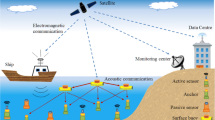Abstract
The integration of technologies under the underwater internet of things (UIoT) paradigm allows the interconnectivity of sensors, smartphones, cameras, animals, people, plants, etc., in aquatic environments, promoting accessible communication and the generation of information on topics of interest such as the conservation of fauna or flora, the composition of elements in the water, the tracking of objects such as semi-autonomous vehicles, or the location of surfers, bathers, among others, who sometimes focus on obtaining data without considering the effects that some types of communication or devices can cause to the environment. For this reason, in this work a UIoT architecture composed of three layers is proposed: detection, networking and storage, which allows the collection of data from different geographical points, through mobile nodes that are activated when they are close to the line of sight. of fixed nodes that have RFID readers, which work at a frequency of 125 kHz, enabling with this type of technology low energy consumption, a high integration scale and low emission of electromagnetic waves, which by implementing low frequencies we have as a result smart nodes that are friendly to the environment in which they are located.
Access this chapter
Tax calculation will be finalised at checkout
Purchases are for personal use only
Similar content being viewed by others
References
Gokhale, P.B.: Introduction to IOT. Int. Adv. Res. J. Sci. Eng. Technol. 5, 41–44 (2018)
Sarma, S.B.: The networked physical world. In: Auto-ID Center White Paper MIT-AUTOID-WH-001, pp. 1–16 (2000)
Zviedris, R., Elsts, A., Strazdins, G., Mednis, A., Selavo, L.: Lynxnet: wild animal monitoring using sensor networks. In: Marron, P.J., Voigt, T., Corke, P., Mottola, L. (eds.) Real-world Wireless Sensor Networks. LNCS, vol. 6511, pp. 170–173. Springer, Heidelberg (2010). https://doi.org/10.1007/978-3-642-17520-6_18
Adamo, F.A.: A smart sensor network for sea water quality monitoring. IEEE Sens. J. 15(5), 2514–2522 (2014)
Nayyar, A., Ba, C.H., Duc, N.P.C., Binh, H.D.: Smart-IoUT 1.0: a smart aquatic monitoring network based on Internet of Underwater Things (IoUT). In: Duong, T.Q., Vo, N.-S. (eds.) Industrial Networks and Intelligent Systems. LNICSSITE, vol. 257, pp. 191–207. Springer, Cham (2019). https://doi.org/10.1007/978-3-030-05873-9_16
Qiu, T.Z.: Underwater internet of things in smart ocean: system architecture and open issues. IEEE Trans. Ind. Inform. 16(7), 4297–4307 (2019)
Hungría, E.M.: La protección de la biodiversidad marina frente al ruido subacuáticoes necesario incorporar valores umbral? Revista de la Escuela Jacobea de Posgrado. 19, 73-96 (2020). http://revista.jacobea.edu.mx
Mooney, T.A.: Sonar-induced temporary hearing loss in dolphins. Biol. Lett. 5(4), 565–567 (2009)
Aznar, Á.C.: Antenas. Universitat Politécnica Catalunya, Barcelona (2004)
Ahson, S.: RFID Handbook: Applications, Technology, Security, and Privacy. CRC Press, Florida, USA (2017)
ISO (1996). ISo. https://www.iso.org/obp/ui/#iso:std:iso:11784:ed-2:v1:en
Co, S.X.: Shenzhen Xinyetong Technology. (Shenzhen Xinyetong Technology CO.) (2008). https://www.asiarfid.com/es/lf-hf-uhf-frequency.html. Accessed 04 Jan 2022
Acknowledgement
The authors acknowledge the Instituto Politécnico Nacional, the Unidad Profesional Interdisciplinaria en Ingeniería y Tecnologías Avanzadas, the Postgraduate Studies and Research Section of the UPIITA-IPN. This work was supported in part by the Secretaria de Investigación y Posgrado-IPN, under the research with registration number 20220542 and by Secretaria de Educación, Ciencia Tecnología e Inovación de la CDMX, under the reasearch with registration number Sectei /143/2021.
Author information
Authors and Affiliations
Corresponding author
Editor information
Editors and Affiliations
Rights and permissions
Copyright information
© 2022 The Author(s), under exclusive license to Springer Nature Switzerland AG
About this paper
Cite this paper
Pallares-Calvo, A.E., Carvajal-Gámez, B.E., Gutiérrez-Frías, O.O. (2022). Architecture of a Network of Low-Frequency Smart Sensors for IoT Applications in Marine Environments. In: Stephanidis, C., Antona, M., Ntoa, S., Salvendy, G. (eds) HCI International 2022 – Late Breaking Posters. HCII 2022. Communications in Computer and Information Science, vol 1655. Springer, Cham. https://doi.org/10.1007/978-3-031-19682-9_68
Download citation
DOI: https://doi.org/10.1007/978-3-031-19682-9_68
Published:
Publisher Name: Springer, Cham
Print ISBN: 978-3-031-19681-2
Online ISBN: 978-3-031-19682-9
eBook Packages: Computer ScienceComputer Science (R0)




